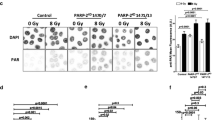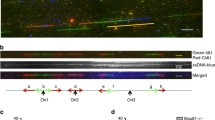Abstract
We have studied the clonogenic survival response to X-rays and MNNG of V79 Chinese hamster cells and two derivative cell lines, ADPRT54 and ADPRT351, deficient in poly(ADP-ribose) polymerase (PARP) activity. Under conditions of exponential growth, both PARP-deficient cell lines are hypersensitive to X-rays and MNNG compared to their parental V79 cells. In contrast, under growth-arrested, confluent conditions, V79 and PARP-deficient cells become similarly sensitive to X-rays and MNNG suggesting that PARP may be involved in the repair of X-ray or MNNG-induced DNA damage in logarithmically growing cells but not in growth-arrested confluent cells. This suggestion, however, creates a dilemma as to how PARP can be involved in DNA repair in only selected growth phases while it is functionally active in all growth phases. To explain these paradoxical results and resolve this dilemma we propose a hypothesis based on the consistent observation that inhibition of PARP results in a significant increase in sister chromatid exchange (SCEs). Thus, we propose that PARP is a guardian of the genome that protects against DNA recombination. We have extended this theme to provide an explanation for our results and the studies done by many others.
Similar content being viewed by others
References
Berger NA: Poly(ADP-ribose) in the cellular response to DNA damage. Radiat Res 101: 4–15, 1985
Ueda K, Hayaishi O: ADP-ribosylation. Annu Rev Biochem 54: 73–100, 1985
Althaus FR, Richter C: ADP-ribosylation of proteins. Enzymology and biological significance. Mol Biol Biochem Biophys 37: 1–237, 1987
Alvarez-Gonzalez R, Jacobson MK: Characterization of polymers of adenosine diphosphate ribose generated in vitro and in vivo. Biochemistry 26: 3218–3224, 1987
Alvarez-Gonzalez R, Althaus FR: Poly(ADP-ribose) catabolism in mammalian cells exposed to DNA-damaging agents. Mutat Res 218: 67–74, 1989
Alvarez-Gonzalez R, Pacheco-Rodriguez G, Mendoza-Alvarez H: Enzymology of ADP-ribose polymer synthesis. Mol Cell Biochem 138: 33–37, 1994
Mendoza-Alvarez H, Alvarez-Gonzalez R: Poly(ADP-ribose) polymerase is a catalytic dimer and the automodification reaction is intermolecular. J Biol Chem 268: 22575–22580, 1993
Lautier D, Lagueux J, Thibodeau J, Menard L, Poirier GG: Molecular and biochemical features of poly (ADP-ribose) metabolism. Mol Cell Biochem 122: 171–193, 1993
Berger NA, Berger SJ: Metabolic consequences of DNA damage: The role of poly (ADP-ribose) polymerase as mediator of the suicide response. Basic Life Sci 38: 357–363, 1986
Berger NA, Sims JL, Catino DM, Berger SJ: Poly(ADP-ribose) polymerase mediates the suicide response to massive DNA damage: Studies in normal and DNA-repair defective cells. Princess Takamatsu Symp 13: 219–226, 1983
Chatterjee S, Cheng MF, Berger RB, Berger SJ, Berger NA: Effect of inhibitors of poly(ADP-ribose) polymerase on the induction of GRP78 and subsequent development of resistance to etoposide. Cancer Res 55: 868–873, 1995
Chatterjee S, Cheng MF, Berger SJ, Berger NA: Induction of M(r) 78,000 glucose-regulated stress protein in poly(adenosine diphosphateribose) polymerase-and nicotinamide adenine dinucleotide-deficient V79 cell lines and its relation to resistance to the topoisomerase II inhibitor etoposide. Cancer Res 54: 4405–4411, 1994
Whitacre CM, Hashimoto H, Tsai ML, Chatterjee S, Berger SJ, Berger NA: Involvement of NAD-poly(ADP-ribose) metabolism in p53 regulation and its consequences. Cancer Res 55: 3697–3701, 1995
Hori T: High incidence of sister chromatid exchanges and chromatid interchanges in the conditions of lowered activity of poly(ADPribose) polymerase. Biochem Biophys Res Commun 102: 38–45, 1981
Morgan WF, Bodycote J, Doida Y, Fero ML, Hahn P, Kapp LN: Spontaneous and 3–aminobenzamide-induced sister-chromatid exchange frequencies estimated by ring chromosome analysis [published erratum appears in Mutagenesis 1988 May; 3(3): 2861.] Mutagenesis 1: 453–459, 1986
Morgan WT, Wolff S: Induction of sister chromatid exchange by 3–aminobenzamide is independent of bromodeoxyuridine. Cytogenet Cell Genet 38: 34–38, 1984
Natarajan AT, Csukas I, van Zeeland AA: Contribution of incorporated 5–bromodeoxyuridine in DNA to the frequencies of sister-chromatid exchanges induced by inhibitors of poly-(ADP-ribose)polymerase. Mutat Res 84: 125–132, 1981
Oikawa AH, Tohda H, Kanai M, Miwa M, Sugimura T: Inhibitors of poly(adenosine diphosphate ribose) polymerase induce sister chromatid exchanges. Biochem Biophys Res Commun 97: 1311–1316, 1980
Utakoji T, Hosoda K, Umezawa K, Sawamura M, Matsushima T, Miwa M, Sugimura T: Induction of sister chromatid exchanges by nicotinamide in Chinese hamster lung fibroblasts and human lymphoblastoid cells. Biochem Biophys Res Commun 90: 1147–1152, 1979
Chatterjee S, Hirschler NV, Petzold SJ, Berger SJ, Berger NA: Mutant cells defective in poly(ADP-ribose) synthesis due to stable alterations in enzyme activity or substrate availability. Exp Cell Res 184: 1–15, 1989
Chatterjee S, Petzold SJ, Berger SJ, Berger NA: Strategy for selection of cell variants deficient in poly(ADP-ribose) polymerase. Exp Cell Res 172: 245–257, 1987
Schreffier V, Hunting D, Trucco C, Gowans B, Grunwald D, De Murcia G, De Murcia JM: A dominant-negative mutant of human poly(ADPribose) polymerase affects cell recovery, apoptosis, and sister chromatid exchange following DNA damage. Proc Natl Acad Sci USA 92: 4753–4757, 1995
Haidacher D, Ebner M, Berghammer H, Auer B: Poly(ADP-ribosyl) transferase (ADPRT) deficient cell lines: A model system to examine the biological role of ADPRT. The 12th International Symposium on ADP-ribosylation Reactions: From Bacterial Pathogenesis to Cancer, Abstract #13, 1997
Nakayasu M, Shima H, Aonuma S, Nakagama H, Nagao M, Sugimura T: Deletion of transfected oncogenes from NIH 3T3 transformants by inhibitors of poly(ADP-ribose) polymerase. Proc Natl Acad Sci USA 85: 9066–9070, 1988
Farzaneh F, Panayotou GN, Bowler LD, Hardas BD, Broom T, Walther C, Shall S: ADP-ribosylation is involved in the integration of foreign DNA into the mammalian cell genome. Nucleic Acids Res 16: 11319–11326, 1988
Waldman AS, Waldman BC: Stimulation of intrachromosomal homologous recombination in mammalian cells by an inhibitor of poly(ADP-ribosylation). Nucleic Acids Res 19: 5943–5947, 1991
Waldman BC, Waldman AS: Illegitimate and homologous recombination in mammalian cells: Differential sensitivity to an inhibitor of poly(ADP-ribosylation). Nucleic Acids Res 18: 5981–5988, 1990
Morgan MT, Cleaver JE: 3–Aminobenzamide synergistically increases sister-chromatid exchanges in cells exposed to methyl methanesulfonate but not to ultraviolet light. Mutat Res 104: 361–366, 1982
Park SD, Kim CG, Kim MG: Inhibitors of poly(ADP-ribose) polymerase enhance DNA strand breaks, excision repair, and sister chromatid exchanges induced by alkylating agents. Environ Mutagen 5: 515–525, 1983
Schwartz JL, Morgan WF, Weichselbaum RR: Different efficiencies of interaction between 3–aminobenzamide and various monofunctional alkylating agents in the induction of sister chromatid exchanges. Carcinogenesis 6: 699–704, 1985
Ben Hur E: Involvement of poly (ADP-ribose) in the radiation response of mammalian cells. Int J Rad Biol Rel Stud Phys Chem Med 46: 659–671, 1984
Cleaver JE, Morgan WF: Poly(ADP-ribose)polymerase: A perplexing participant in cellular responses to DNA breakage. Mutat Res 257: 148, 1991
Shall S: ADP-ribose in DNA repair: A new component of DNA excision repair. Adv Rad Biol 11: 1–69, 1984
Chatterjee S, Berger NA: Poly(ADP-ribose) polymerase in response to DNA damage. Chapter 22, In: J.A. Nickoloff, M. Hoekstra (eds). DNA Damage and Repair-Biochemistry, Genetics and Cell Biology, vol 2. Humana Press, 487–515, 1998
Jacobson EL, Meadows R, Measel J: Cell cycle perturbations following DNA damage in the presence of ADP-ribosylation inhibitors. Carcinogenesis 6: 711–714, 1985
Jacobson EL, Smith JY, Wielckens K, Hilz H, Jacobson MK: Cellular recovery of dividing and confluent C3H10T1/2 cells from N-methyl-N′-nitro-N-nitrosoguanidine in the presence of ADP-ribosylation inhibitors. Carcinogenesis 6: 715–718, 1985
Boorstein RJ, Pardee AB: 3–Aminobenzamide is lethal to MMSdamaged human fibroblasts primarily during S phase. J Cell Physiol 120: 345–353, 1984
Chatterjee S, Berger NA: Growth-phase-dependent response to DNA damage in poly(ADP-ribose) polymerase deficient cell lines: Basis for a new hypothesis describing the role of poly(ADP-ribose) polymerase in DNA replication and repair. Mol Cell Biochem 138: 61–69, 1994
Chatterjee S, Cheng MF, Berger SJ, Berger NA: Alkylating agent hypersensitivity in poly(adenosine diphosphate-ribose) polymerase deficient cell lines. Cancer Commun 3: 71–75, 1991
Chatterjee S, Cheng MF, Trivedi D, Petzold SJ, Berger NA: Camptothecin hypersensitivity in poly(adenosine diphosphate-ribose) polymerase-deficient cell lines. Cancer Commun 1: 389–394, 1989
Chatterjee S, Trivedi D, Petzold SJ, Berger NA: Mechanism of epipodophyllotoxin-induced cell death in poly(adenosine diphosphateribose) synthesis-deficient V79 Chinese hamster cell lines. Cancer Res 50: 2713–2718, 1990
Chatterjee S, Cheng MF, Berger NA: Hypersensitivity to clinically useful alkylating agents and radiation in poly(ADP-ribose) polymerasedeficient cell lines. Cancer Commun 2: 401–407, 1990
Ferro AM, Olivera BM: Poly(ADP-ribosylation) in vitro. Reaction parameters and enzyme mechanism. J Biol Chem 257: 7808–7813, 1982
Zahradka P, Ebisuzaki K: A shuttle mechanism for DNA-protein interactions. The regulation of poly(ADP-ribose) polymerase. Eur J Biochem 127: 579–585, 1982
Althaus FR, Hofferer L, Klewkowska HE, Malanga M, Naegeli H, Panzeter PL, Realini CA: Histone shuttling by poly ADP-ribosylation. Mol Cell Biochem 138: 53–59, 1994
Berger NA, Chatterjee S, Schmotzer JA, Helms SR: Etoposide (VP-16–213)-induced gene alterations: Potential contribution to cell death. Proc Natl Acad Sci 88: 8740–8743, 1991
Friedberg EC, Walker GC, Siede W: DNA repair and Mutagenesis. Am Soc Microbiol Washington DC, 1995
Wiencke JK, Morgan WF: Cell cycle-dependent potentiation of X-ray-induced chromosomal aberrations by 3–aminobenzamide. Biochem Biophys Res Commun 143: 372–376, 1987
Ding R, Pommier Y, Kang VH, Smulson M: Depletion of poly(ADPribose) polymerase by antisense RNA expression results in a delay in DNA strand break rejoining. J Biol Chem 267: 12804–12812, 1992
Ding R, Smulson M: Depletion of nuclear poly(ADP-ribose) polymerase by antisense RNA expression: Influences on genomic stability, chromatin organization, and carcinogen cytotoxicity. Cancer Res 54: 4627–4634, 1994
Stevnsner T, Ding R, Smulson M, Bohr VA: Inhibition of gene-specific repair of alkylation damage in cells depleted of poly(ADP-ribose) polymerase. Nucleic Acids Res 22: 4620–4624, 1994
Kupper JH, de Murcia G, Burkle A: Inhibition of poly(ADPribosyl) ation by overexpressing the poly(ADP-ribose) polymerase DNA-binding domain in mammalian cells. J Biol Chem 265: 18721–18724, 1990
Molinete M, Vermeulen W, Burkle A, de Murcia JM, Kupper JH, Hoeijrnakers JH, de Murcia G: Overproduction of the poly(ADPribose) polymerase DNA-binding domain blocks alkylation-induced DNA repair synthesis in mammalian cells. EMBO J 12: 2109–2117, 1993
Satoh MS, Lindahl T: Role of poly(ADP-ribose) formation in DNA repair. Nature 356: 356–358, 1992
Satoh MS, Poirier GG, Lindahl T: Dual function for poly(ADP-ribose) synthesis in response to DNA strand breakage. Biochemistry 33: 7099–8106, 1994
Satoh MS, Poirier GG, Lindahl T: NAD(+)-dependent repair of damaged DNA by human cell extracts. J Biol Chem 268: 5480–5487, 1993
Creissen D, Shall S: Regulation of DNA ligase activity by poly(ADPribose). Nature 296: 271–272, 1982
Hunting DJ, Gowans BJ, Henderson JF: Specificity of inhibitors of poly(ADP-ribose) synthesis. Effects of nucleotide metabolism in cultured cells. Mol Pharmacol 28: 200–206, 1985
Milam KM, Thomas GH, Cleaver: Disturbances in DNA precursor metabolism associated with exposure to an inhibitor of poly(ADPribose) synthetase. Exp Cell Res 165: 260–268, 1986
Cleaver JE, Morgan WF: Poly(ADP-ribose) synthesis is involved in the toxic effects of alkylating agents but does not regulate DNA repair. Mutation Res 150: 69–76, 1985
Cleaver JE, Milam KM, Morgan W: Do inhibitor studies demonstrate a role for poly(ADP-ribose) in DNA repair? Radiat Res 101: 16–28, 1985
Author information
Authors and Affiliations
Rights and permissions
About this article
Cite this article
Chatterjee, S., Berger, S.J. & Berger, N.A. Poly(ADP-ribose) polymerase: A guardian of the genome that facilitates DNA repair by protecting against DNA recombination. Mol Cell Biochem 193, 23–30 (1999). https://doi.org/10.1023/A:1006983304079
Issue Date:
DOI: https://doi.org/10.1023/A:1006983304079




